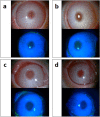Development and Effects of FTY720 Ophthalmic Solution on Corneal Allograft Survival
- PMID: 26558849
- PMCID: PMC4642302
- DOI: 10.1038/srep16468
Development and Effects of FTY720 Ophthalmic Solution on Corneal Allograft Survival
Abstract
Fingolimod (FTY720), a novel class of sphingosine 1-phosphate receptor modulators, has received special interest among ophthalmologists, particularly given that oral administration of FTY720 has proven to effectively treat corneal graft rejection in animal models. However, no studies have examined the performance of FTY720 as an ophthalmic solution in reducing corneal rejection in high-risk corneal rejection models, and the stability and ocular irritation profile of FTY720 ophthalmic solution are also unknown. Thus, we developed 0.1%, 0.2% and 0.5% FTY720 ophthalmic solutions and evaluated their chemical stabilities under various storage conditions with high- performance liquid chromatography. To investigate the ocular irritancy of the FTY720 ophthalmic solution, New Zealand albino rabbits were subjected to the Draize test. Furthermore, classic, well-established rat allogenic penetrating keratoplasty models were used to investigate the anti-rejection efficacy of the tested FTY720 ophthalmic solutions. We found that the non-irritating 0.5% FTY720 ophthalmic solution could prolong corneal allograft survival in rats with significant efficacy for about one month. Furthermore, no significant concentration changes occurred in any of the types of FTY720 ophthalmic solutions within three months. These results revealed crucial profiles of FTY720 ophthalmic solutions and warrant further investigation and optimization of FTY720 in the anti-rejection therapy after keratoplasty.
Figures





Similar articles
-
Rapamycin Nano-Micelle Ophthalmic Solution Reduces Corneal Allograft Rejection by Potentiating Myeloid-Derived Suppressor Cells' Function.Front Immunol. 2018 Oct 8;9:2283. doi: 10.3389/fimmu.2018.02283. eCollection 2018. Front Immunol. 2018. PMID: 30349533 Free PMC article.
-
Topical application of FTY720 and cyclosporin A prolong corneal graft survival in mice.Mol Vis. 2012;18:624-33. Epub 2012 Mar 9. Mol Vis. 2012. PMID: 22509094 Free PMC article.
-
Effects of topical sphingosine-1-phosphate 1 receptor agonist on corneal allograft in mice.Cornea. 2014 Apr;33(4):398-404. doi: 10.1097/ICO.0000000000000077. Cornea. 2014. PMID: 24573171
-
Rejection and acceptance of corneal allografts.Curr Opin Organ Transplant. 2009 Feb;14(1):4-9. doi: 10.1097/MOT.0b013e32831af1d7. Curr Opin Organ Transplant. 2009. PMID: 19337139 Review.
-
Immunoglobulin deposition in the cornea after application of autologous serum.Arch Ophthalmol. 1988 Oct;106(10):1423-5. doi: 10.1001/archopht.1988.01060140587028. Arch Ophthalmol. 1988. PMID: 3052385 Review.
Cited by
-
Corneal pain and experimental model development.Prog Retin Eye Res. 2019 Jul;71:88-113. doi: 10.1016/j.preteyeres.2018.11.005. Epub 2018 Nov 16. Prog Retin Eye Res. 2019. PMID: 30453079 Free PMC article. Review.
-
miR-151-5p alleviates corneal allograft rejection by activating PI3K/AKT signaling pathway and balancing Th17/Treg after corneal transplantation via targeting IL-2Rɑ.Ann Transl Med. 2021 Sep;9(18):1410. doi: 10.21037/atm-21-2054. Ann Transl Med. 2021. PMID: 34733962 Free PMC article.
-
Angiogenesis and lymphangiogenesis in corneal transplantation-A review.Surv Ophthalmol. 2018 Jul-Aug;63(4):453-479. doi: 10.1016/j.survophthal.2017.12.008. Epub 2017 Dec 27. Surv Ophthalmol. 2018. PMID: 29287709 Free PMC article. Review.
-
Loss of miR-673-5p expression in the cornea promotes rat corneal allograft rejection by promoting Th17 cell differentiation mediated by JAK2/STAT3.Ann Transl Med. 2021 Sep;9(18):1409. doi: 10.21037/atm-21-2051. Ann Transl Med. 2021. PMID: 34733961 Free PMC article.
-
Rapamycin Nano-Micelle Ophthalmic Solution Reduces Corneal Allograft Rejection by Potentiating Myeloid-Derived Suppressor Cells' Function.Front Immunol. 2018 Oct 8;9:2283. doi: 10.3389/fimmu.2018.02283. eCollection 2018. Front Immunol. 2018. PMID: 30349533 Free PMC article.
References
-
- Reinhart W. J. et al. Deep anterior lamellar keratoplasty as an alternative to penetrating keratoplasty a report by the american academy of ophthalmology. Ophthalmology 118, 209 (2011). - PubMed
-
- Panda A., Vanathi M., Kumar A., Dash Y. & Priya S. Corneal graft rejection. Surv Ophthalmol 52, 375 (2007). - PubMed
-
- Williams K. A., Lowe M., Bartlett C., Kelly T. L. & Coster D. J. Risk factors for human corneal graft failure within the Australian corneal graft registry. Transplantation 86, 1720 (2008). - PubMed
-
- Alldredge O. C. & Krachmer J. H. Clinical types of corneal transplant rejection. Their manifestations, frequency, preoperative correlates, and treatment. Arch Ophthalmol 99, 599 (1981). - PubMed
Publication types
MeSH terms
Substances
LinkOut - more resources
Full Text Sources
Other Literature Sources

